Abstract
Quasicrystal alloys have a wide application prospect because of excellent performances and characteristics; meanwhile, magnesium alloys are known as green engineering materials because of their high specific strength and light weight. Therefore, the study of Mg-Zn-Gd quasicrystal alloys is of great significance for the development of new materials. In this paper, Mg(70-x)Zn30Gdx(x=3,4,5) alloys were prepared by a conventional casting method and the morphologies and properties of these alloys were studied. There was a new symmetrical rod phase found in the Mg66Zn30Gd4 alloy and the symmetrical rod phase was identified as a ternary phase by mapping scanning and energy dispersive spectroscopy (EDS) analysis. The Zn/Gd ratio of the symmetrical rod phase was found to be 4.8 and the TEM images obtained were different from the typical diffraction spots patterns of quasicrystalline, which means it is unlikely to be quasicrystalline. With different melt holding time, the symmetrical rod phase evolved gradually over time from a lamellar eutectic structure; differential scanning calorimetry (DSC), heat treatment, and microhardness tests showed that the melting temperature of the rod phase was 453 °C and that its thermal stability and microhardness are better than quasicrystalline. Hence, the symmetrical rod phase is a new kind of complex metallic alloy phase whose composition and properties are close to those of quasicrystals but is not quasicrystalline.
1. Introduction
As the lightest green engineering structural material, magnesium alloy has many advantages, including high specific strength and stiffness, good shock and noise reduction performance, electromagnetic shielding, and easy processing and forming, etc. It has broad application prospects in transportation, aerospace, and military industries [1]. Shechtman et al. [2] first found the quasicrystalline phase in an Al-Mn quench alloy system in 1984. Unlike traditional crystals, quasicrystals have special symmetry of five or more times [3,4,5,6]. This structural particularity also makes them have high hardness and strength, as well as low friction coefficients, strong thermal stability, and corrosion resistance [7,8,9]. Therefore, introducing quasicrystals as a dispersion strengthening phase into magnesium alloys can theoretically compensate for the shortcomings of traditional magnesium alloys [10].
Quasicrystalline alloys have received more and more attention and recognition in recent decades [11,12]. In addition, studying the factors that affect the formation of quasicrystals for the synthesis and application of quasicrystals is significant. There are many factors affecting the formation of quasicrystals according to former studies, including cooling rate, composition, electronic structure, and melt treatment [13].
The quasicrystalline alloys of Mg-Zn-Re (where Re = rear earth element) have been extensively researched. It has been confirmed that the Zn/Y ratios of I-phase (Mg3Zn6Y1) and W-phase (Mg3Zn3Y2) are 6 and 1.5, respectively [14]. These ratios are in accordance with those for Mg-Zn-Gd alloys. In addition, W’-phase, H-phase, and other phases, which have different structures, exist in quasicrystalline alloys. Therefore, making a profound study of the structures and relationships between different phases will aid in obtaining a good understanding of the interlink among phases, which is of great significance to the study of the atomic structure of strengthened phases in high-performance magnesium alloys.
For Mg-Zn-Gd alloys, the icosahedral quasicrystal phase (I-phase) has been confirmed as being able to be made as an equilibrium phase during solidification or crystallization in a certain range of elemental components and holding time [15,16]. When the components or holding time change, the composition, structure, and symmetry of phases may change. In this paper, we prepared different Mg(70-x)Zn30-Gdx(x=3,4,5) (at. %) alloys and investigated the composition, structure, and symmetry of phases. This work focuses on the metastable phases in the Mg-Zn-Gd system; the formation mechanism of the symmetrical rod phase is also discussed.
2. Materials and Methods
The experimental ternary alloys with nominal component Mg(70-x)Zn30Gdx(x=3,4,5) (at. %) were prepared by melting high-purity Mg (99.98 wt %), Zn (99.96 wt %), and master alloy Mg-Gd (30.21 wt %) in an electric resistance furnace. Firstly, Mg and Mg-30.21 wt % Gd alloys were placed into a graphite-clay crucible. When the temperature reached 720 °C and the alloys previously added had melted, Zn was added into the molten metal. After all the alloys had become molten, the melt was kept at 720 °C for minutes. The melt was then poured into a 200 °C preheated steel mold and cooled slowly in the atmosphere. Protective gas composed of CO2 and SF6 was always in the process of smelting to prevent evaporation and oxidation of components during smelting.
X-ray diffraction (Bruker D8 Advance) employing Cu Kα radiation was used to determine the constitution of phases with a scanning rate of ~5° min−1. The microstructure and morphology were characterized by SEM (FEI-QUANTA FEG250) equipped with EDS (X-MAX50) for analyzing the local chemical compositions of different phases and TEM (JEM-2100). The thermal stability and microhardness of phases was researched by DSC (HCT-1) and a Rockwell hardness tester. Sample preparations for TEM observations were made up of mechanical polishing and ion-beam thinning (GATAN-691).
3. Results
3.1. Microstructure and Composition
SEM images of Mg-Zn-Gd alloys with different content of Gd after holding for 40 min are displayed in Figure 1. The content of Gd in the Mg-Zn-Gd alloys seen in Figure 1a–c is 3 at. %, 4 at. %, and 5 at. %, respectively. It can be clearly seen that the phase morphologies of the alloys changed significantly. When the content of Gd is 3 at. % in the Mg(70-x)Zn30-Gdx alloy (Figure 1a), three main phases are included in the alloy: a light grey pentapetaloid phase, a black punctate phase, and a dark grey matrix phase. According to the XRD patterns shown in Figure 2, these phases may be judged to be I-phase, α-Mg phase, Mg7Zn3 phase, respectively. This is consistent with the report in the literature by Gröbner et al. [17]. The TEM images of the light grey pentapetaloid phase (shown in Figure 5a,b) also appear to be a typical quasicrystal diffraction spot, which can also prove that the light grey pentapetaloid phase is an icosahedral quasicrystal (I-phase).
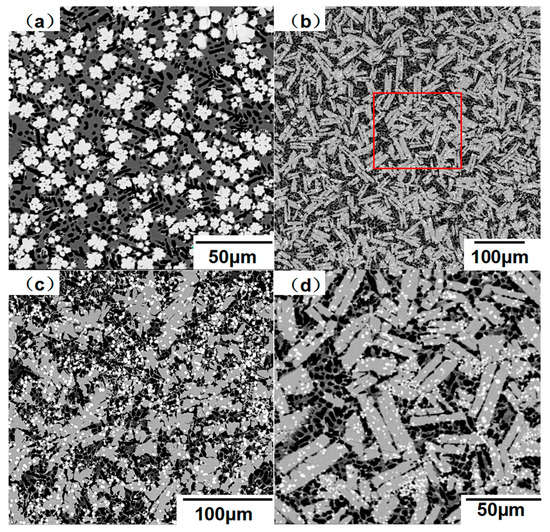
Figure 1.
Mg-Zn-Gd alloys with different Gd content after holding for 40 min: (a) Mg67Zn30Gd3; (b) Mg66Zn30Gd4; (c) Mg65Zn30Gd5; (d) locally enlarged image of (b).
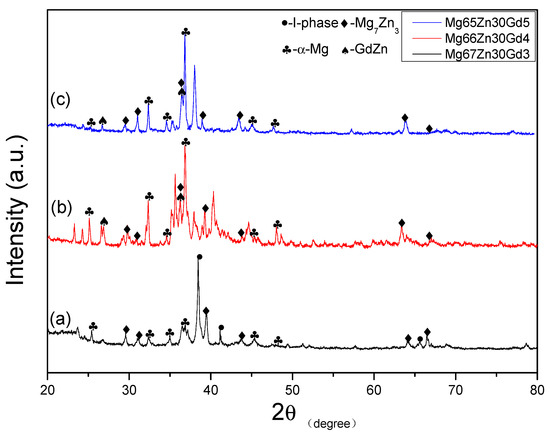
Figure 2.
XRD patterns of different Mg-Zn-Gd alloys: (a) Mg67Zn30Gd3; (b) Mg66Zn30Gd4; (c) Mg65Zn30Gd5.
Figure 1b is an SEM image of the Mg66Zn30Gd4 alloy and Figure 1d is a local enlargement of Figure 1b. When the content of Gd reaches 4 at. %, the major phases except the black phase α-Mg and dark grey phase Mg7Zn3 are the light grey symmetrical rod phase and white punctate phase, which can be clearly seen from Figure 1d. The distribution of the symmetrical rod phase is disorderly and its length is 20 μm to 50 μm. The white punctate phase is dispersed in the alloy with a small volume. In the Mg65Zn30Gd5 alloy (Figure 1c), the other three phases do not change a lot but the light grey phase appears irregularly shaped, which is quite different from the symmetrical rod phase.
As shown in the XRD patterns (Figure 2), when the content of Gd is 3 at. %, the peaks of the I-phase appear in the pattern of Figure 2a. However, the I-phase peaks are not detected in patterns of alloys with 4 at. % and 5 at. % Gd. On the contrary, in Figure 2b,c, phase Gd-Zn is found and there are obvious peaks in the places where 2θ is 23, 24.2, 36, 38, and 40.5, and these peaks are not the diffraction peaks of the other three phases. Thus, it can be inferred that these peaks may be the diffraction peaks of the symmetrical rod phase. Hence, deducing from Figure 1 and Figure 2, the symmetrical rod phase is unlikely to be the icosahedral phase of quasicrystals.
Figure 3 is a mapping scanning analysis of the main morphologies of the Mg66Zn30Gd4 alloy. It is obvious that the white punctate phase appears black in Mg and bright in the Zn and Gd graphs. This means that the white punctate phase contains almost no Mg element but embodies Zn and Gd, which is a kind of Gd-Zn alloy. By analyzing Figure 2 and Figure 3, it can be approximately determined that the white punctate phase is the Gd-Zn phase. The white punctate phase Gd-Zn is mostly distributed over the symmetrical rod phase. Hence, the formation of this phase maybe due to the increase of Gd content, which means that the excess Gd element precipitates during the solidification of the alloy and reacts with Zn to form the Gd-Zn phase. In addition, the light grey symmetrical rod phase has bright colors in all three scanning images, meaning that the phase can be ascertained as a ternary phase containing Mg, Zn, and Gd elements.
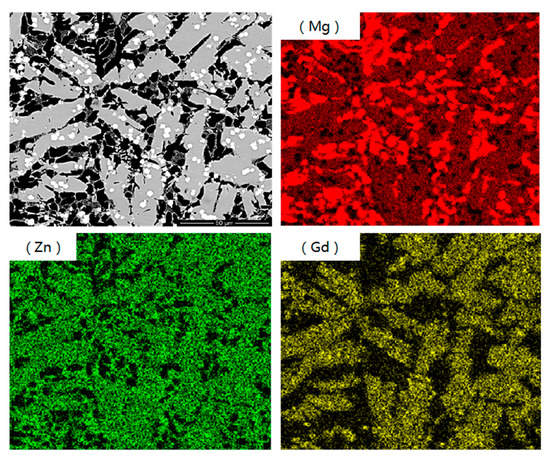
Figure 3.
Mapping scanning analysis of the Mg66Zn30Gd4 alloy.
To further research the phase composition, EDS analysis of the pentapetaloid I-phase and symmetrical rod phase was carried out. As shown in Figure 4, points 1 and 2 are the constituents of the pentapetaloid I-phase and the symmetrical rod phase, respectively. The atomic composition of the pentapetaloid I-phase is 65.82 at. % Mg, 29.22 at. % Zn, and 4.96 at. % Gd. Thus, it can be seen that the ratio of Zn/Gd in the pentapetaloid I-phase is 5.89, which is very close to the theoretical value Mg3Zn6Gd1 [18] of the quasicrystalline phase in the Mg-Zn-Re system. The existence of the quintic rotational symmetry axis in Figure 5b and the EDS energy spectrum analysis further prove that the determination of the quintic petal phase as a quasicrystal phase is correct. The atomic composition of the symmetrical rod phase is 77.52 at. % Mg, 18.59 at. % Zn, and 3.89 at. % Gd, and the ratio of Zn/Gd is approximately 4.8. This is much less than the theoretical value of quasicrystalline.
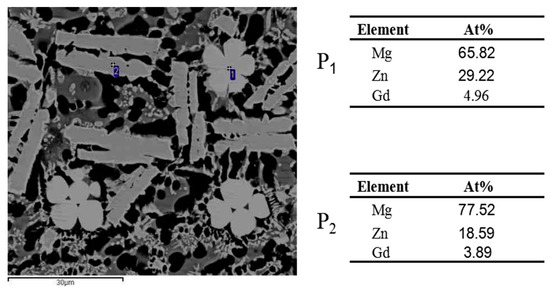
Figure 4.
EDS analysis of different phases: (1) pentapetaloid phase; (2) symmetrical rod phase.
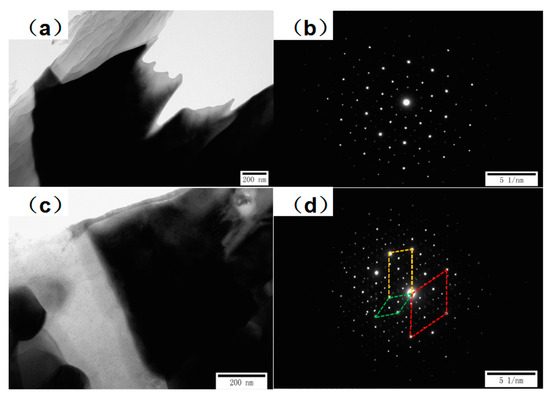
Figure 5.
TEM images of different phases: (a,b) pentapetaloid phase; (c,d) symmetrical rod phase.
Moreover, the TEM images of the symmetrical rod phase are shown in Figure 5c,d. It is obvious that the selected-area electron diffraction spots are very complex and different from the typical diffraction spots pattern (Figure 5b) of quasicrystalline; it may include various phases judging by the signed rectangles of different colors, but it does not include the quasicrystal phase. Jiang et al. [19] have reported that the ratio of Zn/Gd in the W-phase, which is common in Mg-Zn-Re alloys and is similar to the quasicrystalline phase, is about 1.5. As per the previous analysis, the Zn/Gd ratio of the symmetrical rod phase is 4.8, which is not only far from 1.5 ( the ratio of W-phase ), but also different from 6 ( the ratio of I-phase ). Therefore, by analyzing the SEM, XRD, EDS, and TEM graphics of the symmetrical rod phase, the composition of this phase is similar to that of quasicrystals, but its structure does not seem to have the characteristics of typical quasicrystals.
3.2. Morphological Evolution
In order to investigate the formation and stability of the symmetrical rod phase, samples of the Mg66Zn30Gd4 alloy with different holding time at 720 °C were selected for research. As shown in Figure 6a, when the holding time is 5 min, most of the phases in the alloy are strip-like lamellar eutectic phases with a longitudinal midline running through the structure; meanwhile, there are some black α-Mg phases and white dotted Gd-Zn phases, which show that the GdZn phase is easy to form in the solidification of the alloy. After being held for 10 min (Figure 6b), the strip-like lamellar eutectic phases were less than before, and the white dotted phases did not increase significantly; however, the symmetrical rod phases had preliminarily formed. In the blue area of Figure 6c, the symmetrical rod phases had basically formed, and in the red area, it was half rod phase and half lamellar eutectic structure. Hence, it can be inferred that the symmetrical rod phase evolved gradually over time from the lamellar eutectic structure with the longitudinal midline as the demarcation line. When the holding time was 15 min, the evolution of the symmetrical rod phases had finished, and there was no lamellar eutectic structure which remained (Figure 6d). In Figure 6e, the size of the symmetrical rod phase increased to 40–70 μm but the morphologies essentially remained unchanged, which reflected the good stability of the symmetrical rod phase.
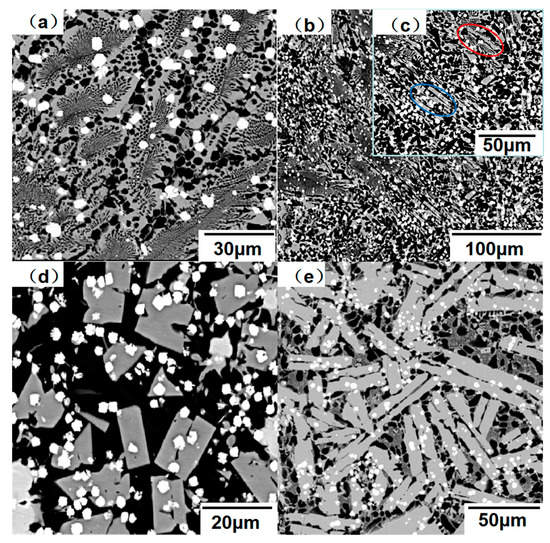
Figure 6.
SEM images of the Mg66Zn30Gd4 alloy after different holding times at 720 °C: (a) 5 min; (b) 10 min; (c) magnification of (b); (d) 15 min; (e) 80 min.
From Figure 7, it can be seen that the XRD diffraction patterns of the alloys after holding for 5, 10, and 15 min are basically the same and they all contain three identical known phases: Mg7Zn3, Gd-Zn and α-Mg. At the same time, peaks appear at positions 23, 24.2, 36, and 40.5 2θ, which is consistent with Figure 2b. Based on the analysis of Figure 6 and Figure 7, it can be inferred that the symmetrical rod phase appeared early in the alloy, and gradually evolved from the lamellar network structure to the symmetrical rod phase structure.
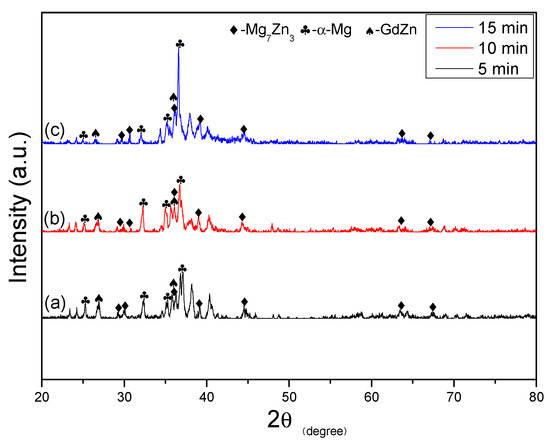
Figure 7.
XRD patterns of the Mg66Zn30Gd4 alloy after different holding times at 720 °C: (a) 5 min; (b) 10 min; (c) 15 min.
3.3. Thermal Stability
In addition, thermodynamic and microhardness tests of the petaloid quasicrystal phase (I-phase) and the symmetrical rod phase were carried out. Figure 8a shows the DSC analysis curves of the Mg67Zn30Gd3 and Mg66Zn30Gd4 alloys. It can be seen that when the temperature reaches 345 °C, both lines have endothermic peaks, which is due to the melting of Mg7Zn3. Another endothermic peak of the Mg67Zn30Gd3 alloy appears at 417 °C, and according to the reports of Zhang et al. [16], this is the melting peak of the petal-like quasicrystal phase; meanwhile, the melting peak of the symmetrical rod phase in the Mg66Zn30Gd4 alloy appears at 453 °C, which means that the symmetrical rod phase may have a better thermal stability than the petal-like quasicrystalline phase. In order to verify the above hypothesis, samples of the Mg67Zn30Gd3 and Mg66Zn30Gd4 alloys were heat-treated at 430 °C for study. The results shown in Figure 8b,c indicate that the morphology of the quasicrystalline phase changed dramatically as a result of melting and that the petal-like morphology became a lamellar network structure; however, the morphology of the symmetrical rod phase remained stable in the main and only a few lamellar eutectic structures occurred in the interior. The microhardness of the quasicrystalline and symmetrical rod phases before and after heat treatment were studied; the results show that the microhardness of the symmetrical rod phase did not decrease obviously but that that of the quasicrystalline phase decreased a lot. All the above analyses prove that the symmetrical rod phase has a better thermal stability than the petal-like quasicrystalline phase.
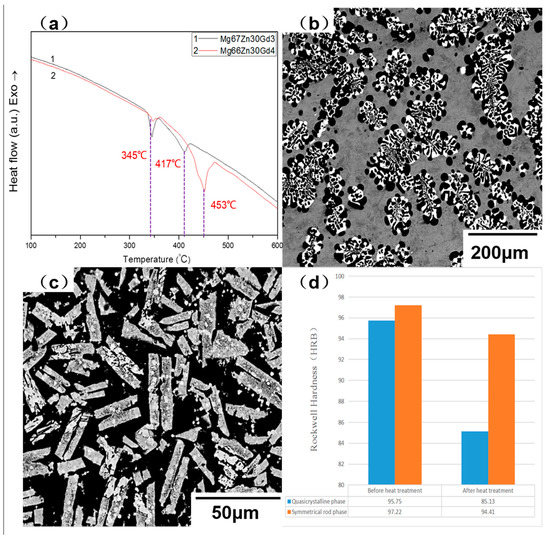
Figure 8.
(a) Differential scanning calorimetry (DSC) analysis curves of the different Mg-Zn-Gd alloys: 1-Mg67Zn30Gd3, 2-Mg66Zn30Gd4; (b,c) SEM images of Mg67Zn30Gd3 and Mg66Zn30Gd4 after heat treatment at 430 °C, respectively; (d) microhardness of the quasicrystalline and symmetrical rod phases before and after heat treatment.
4. Discussion
In this study, the symmetrical rod phase was found in the Mg66Zn30Gg4 alloy but not in the other two alloys considered, which indicates that the formation of the phase is related to the content of Gd, i.e., the ratio of Zn to Gd. The diffraction pattern of the symmetrical rod phase was found to be very complex, probably because it evolved from a lamellar eutectic structure, and its Zn/Gd ratio was observed to be close to the quasicrystal ratio, thus forming a more complex internal structure. Moreover, the increase of thermal stability and microhardness of the phase may also be due to the complex structure of the phase. Because the composition, Zn/Gd ratio, phase transition temperature, and microhardness of the symmetrical rod phase are similar to those of a quasicrystal phase, but its electron diffraction spot does not show the characteristics of a typical quasicrystal phase, we consider it to be a new kind of complex metallic alloy phase whose composition and properties are close to those of quasicrystals but is not quasicrystalline. The specific spatial structure and related parameters of the phase need to be further studied in the future.
5. Conclusions
In this work, the Mg(70-x)Zn30Gdx(x=3,4,5) alloys with different content of Gd were prepared and the morphologies and properties of these alloys were studied: (1) the main phases were found to be a pentapetaloid phase for the Mg67Zn30Gd3, a symmetrical rod phase for the Mg66Zn30Gd4 alloy, and an irregularly shaped phase for the Mg65Zn30Gd5 alloy; (2) the symmetrical rod phase was found to consists of three elements (Mg, Zn, and Gd), its Zn/Gd ratio was obtained as 4.8 (which is close to but not in conformity with the requirements of quasicrystals) and its electron diffraction spots were complex and had no obvious quasicrystal phase characteristics; (3) this phase was found to evolve gradually over time from the lamellar eutectic structure and to be able to exist in alloy melt for a long time. The melting temperature of the symmetrical rod phase was 453 °C, and its thermal stability and microhardness were found to be better than those of quasicrystal phase; (4) the composition and phase transition temperature of the symmetrical rod phase were found to be close to those of a quasicrystal phase, but its electron diffraction pattern was seen to have no characteristics of a quasicrystal phase, so it may be a new kind of complex metal alloy phase, and needs further study.
Author Contributions
Conceptualization, J.Y.; data curation, Y.F.; formal analysis, J.Y.; methodology, Y.F.; software, H.W.; validation, G.Z., M.Z., and J.L.; writing—original draft, J.Y.; writing—review and editing, X.T.
Funding
This research was funded by the National Natural Science Foundation of China (grant nos. 51571102, 51701081, and 51871111), the Young-Aged Talents Lifting Project of the Shandong Association for Science and Technology (grant no. 301-1505001, recorded by the University of Jinan), and the Shandong Provincial Natural Science Foundation (grant no. ZR2017BEM001).
Acknowledgments
Thank you to my instructor, the teachers and students of the project group for their help, and also to the fundings.
Conflicts of Interest
The authors declare no conflict of interest.
References
- Yuan, G.; Amiya, K.; Kato, H.; Inoue, A. Structure and mechanical properties of cast quasicrystal-reinforced Mg–Zn–Al–Y base alloys. J. Mater. Res. 2004, 19, 1531–1538. [Google Scholar] [CrossRef]
- Shechtman, D.; Blech, I.; Gratias, D.; Cahn, J.W. Metallic phase with long-range orientational order and no translational symmetry. Phys. Rev. Lett. 1984, 53, 1951. [Google Scholar] [CrossRef]
- Levine, D.; Steinhardt, P.J. Quasicrystals: A new class of ordered structures. Phys. Rev. Lett. 1984, 53, 2477. [Google Scholar] [CrossRef]
- Fischer, S.; Exner, A.; Zielske, K.; Perlich, J.; Deloudi, S.; Steurer, W.; Lindner, P.; Förster, S. Colloidal quasicrystals with 12-fold and 18-fold diffraction symmetry. Proc. Natl. Acad. Sci. USA 2011, 108, 1810–1814. [Google Scholar] [CrossRef] [PubMed]
- Gierer, M.; Hove, M.A.; Goldman, A.I.; Shen, Z.; Chang, S.L.; Jenks, C.J.; Zhang, C.M.; Thiel, P.A. Structural Analysis of the Fivefold Symmetric Surface of the A l 70 P d 21 M n 9 Quasicrystal by Low Energy Electron Diffraction. Phys. Rev. Lett. 1997, 78, 467. [Google Scholar] [CrossRef]
- Zoorob, M.E.; Charlton, M.D.B.; Parker, G.J.; Baumberg, J.J.; Netti, M.C. Complete photonic bandgaps in 12-fold symmetric quasicrystals. Nature 2000, 404, 740–743. [Google Scholar] [CrossRef] [PubMed]
- Gröbner, J.; Kozlov, A.; Fang, X.Y.; Geng, J.; Nie, J.F.; Schmid-Fetzer, R. Phase equilibria and transformations in ternary Mg-rich Mg–Y–Zn alloys. Acta Mater. 2012, 60, 5948–5962. [Google Scholar] [CrossRef]
- Baake, M. Quasicrystals: An Introduction to Structure, Physical Properties and Applications; Suck, J.B., Schreiber, M., Häussler, P., Eds.; Springer: Berlin, Germany, 2002. [Google Scholar]
- Vogel, M.; Kraft, O.; Dehm, G.; Arzt, E. Quasi-crystalline grain-boundary phase in the magnesium die-cast alloy ZA85. Scr. Mater. 2001, 45, 517–524. [Google Scholar] [CrossRef]
- Zhang, J.; Jia, P.; Zhao, D.; Zhou, G.; Teng, X. Melt holding time as an important factor on the formation of quasicrystal phase in Mg67Zn30Gd3 alloy. Phys. B Condens. Matter 2018, 533, 28–32. [Google Scholar] [CrossRef]
- Tanaka, R.; Ohhashia, S.; Fujitaae, N.; Demurabc, M.; Yamamotob, A.; Katod, A.; Tsai, A.P. Application of electron backscatter diffraction (EBSD) to quasicrystal-containing microstructures in the Mg-Cd-Yb system. Acta Mater. 2016, 119, 193–202. [Google Scholar] [CrossRef]
- Jeon, S.Y.; Kwon, H.; Hur, K. Intrinsic photonic wave localization in a three-dimensional icosahedral quasicrystal. Nat. Phys. 2017, 13, 363. [Google Scholar] [CrossRef]
- Huang, H.; Tian, Y.; Yuan, G.; Chen, C.; Ding, W.; Wang, Z. Formation mechanism of quasicrystals at the nanoscale during hot compression of Mg alloys. Scr. Mater. 2014, 78, 61–64. [Google Scholar] [CrossRef]
- Huang, H.; Tian, Y.; Yuan, G.; Chen, C.; Ding, W.; Wang, Z. Precipitation of secondary phase in Mg-Zn-Gd alloy after room-temperature deformation and annealing. J. Mater. Res. Technol. 2018, 7, 135–141. [Google Scholar] [CrossRef]
- Tian, Y.; Huang, H.; Yuan, G.; Chen, C. Nanoscale icosahedral quasicrystal phase precipitation mechanism during annealing for Mg–Zn–Gd-based alloys. Mater. Lett. 2014, 130, 236–239. [Google Scholar] [CrossRef]
- Zhang, J.; Teng, X.; Xu, S.; Ge, X.; Leng, J. Temperature dependence of resistivity and crystallization behaviors of amorphous melt-spun ribbon of Mg66Zn30Gd4 alloy. Mater. Lett. 2017, 189, 17–20. [Google Scholar] [CrossRef]
- Gröbner, J.; Kozlova, A.; Fang, X.Y.; Zhu, S.; Nie, J.F. Phase equilibria and transformations in ternary Mg–Gd–Zn alloys. Acta Mater. 2015, 90, 400–416. [Google Scholar] [CrossRef]
- Sugiyama, K.; Yasuda, K.; Ohsuna, T.; Hiraga, K. The structures of hexagonal phases in Mg-Zn-Re (Re= Sm and Gd) alloys. Z. Fur Krist. 1998, 213, 537–543. [Google Scholar] [CrossRef]
- Jiang, H.; Qiao, X.; Xu, C.; Kamado, S.; Wu, K.; Zheng, M. Influence of size and distribution of W-phase on strength and ductility of high strength Mg-5.1 Zn-3.2 Y-0.4 Zr-0.4 Ca alloy processed by indirect extrusion. J. Mater. Sci. Technol. 2018, 34, 277–283. [Google Scholar] [CrossRef]
© 2019 by the authors. Licensee MDPI, Basel, Switzerland. This article is an open access article distributed under the terms and conditions of the Creative Commons Attribution (CC BY) license (http://creativecommons.org/licenses/by/4.0/).